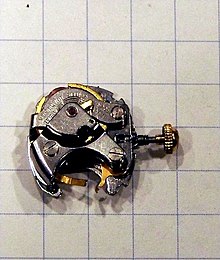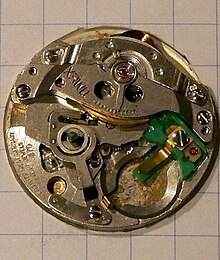Budget Watch Collecting/Timex movements
Jump to navigation
Jump to search

Model 20 
Model 21 
Model 22 
Model 29 
Model 23 
Model 24 
Model 104 
Model 55 
Model 64 
Model 69 from 1977 
Model 78 
Model 100 
Model 84
Many Timex/Ingersoll/US Time movements share common base movements, with extra features and/or modifications.
Note: If you have examples of these movements before or after the dates listed here, please either edit this page, or contact user sevesteen.
Note: Grids are 1/4 per square, scaled so 1 1⁄4-inch equals 400 pixels in the full-size image
Ingersoll Model 20
[edit | edit source]- Ingersoll movement model 20, with or without sweep (this movement is missing sweep specific parts) Has plastic spacers between top and bottom plates, back plate is steel with brass bushings for pivots. Replaced by the model 21 in about 1950

Base Model 21
[edit | edit source]- base movement model 21, variations with and without sweep second. Replaced by model 22 by 1960.
- Model 26 is a 21 with the addition of an automatic winding module first seen in 1956.

Base Model 22
[edit | edit source]- Base movement Model 22 has oval-rectangular plates, balance at 9:00. Differences from model 21: Balance screw moved from dial side to back, cutout on dial side near balance added; thinner profile than the model 21. Introduced in 1958, replaced by the Model 24 series after 1963
- Model 29 is a 22 with the addition of an automatic winding module first seen in 1958.


Base Model 23
[edit | edit source]- Base movement Model 23 is a diamond-shaped movement with the balance at about 8:30. Primarily used in women's watches. In use at least from 1961 to 1979

Base Model 24
[edit | edit source]Base movement Model 24 has an oval-rectangular dial plate, and a mostly circular back plate, with a flat at 2:00. Balance is at 5:00. First used in 1963, continued with minor modifications until mechanical production ended.
- Model 25 is the same as Model 24, with the addition of a date calendar.
- Model 27 is the same as Model 24 with a day/date calendar.
- Model 31 is a Model 24 with an automatic winding module
- Model 32 is a Model 24 with date and automatic winding
- Model 33 is a Model 24 with day/date and automatic wind.
- Model 72 is a Model 24 with jewels and different markings on the back plate.
- Model 74 is a Model 24 with jewels and automatic wind
- Model 104 is nearly identical to Model 24, with simplified click and different dial mounting. Note extra holes in the corners.
- Model 116 appears to be very similar to the 104, with an extended seconds pinion.
- Model 105 is a Model 104 with date.


Base Model 40
[edit | edit source]- Model 40 is early stem-set electric
- Model 41 is a Model 40 with date
- Model 42 is a Model 41 with day and date.
- Model 50, Model 51 and Model 52 are similar to the Model 40, Model 41 and Model 42, with the addition of a diode in the balance assembly.
- Model 55 is a Dynabeat, with 8 beats per second (rather than the standard 6)
- Model 62, Model 63 Model 64 and model 73 are based on the Model 40, with quartz control.
- Model 65 is a Model 51 with a second time zone hand.


Base Model 67
[edit | edit source]- Model 67 First Timex Electric, back set, 11 jewels. Introduced 1962
Base Model 69
[edit | edit source]- Model 69, small women's electric. Not shown in 1965 repair manual, Models seen from 1971 to 1979, could be earlier or later.
- Model 71 with date, examples from 1978 seen

Base Model 70
[edit | edit source]Small women's 17 jewel, produced at least form 1961 to 1965.
Base Model 78
[edit | edit source]- Model 78, oval bottom plate, round top plate with a flat side, balance at 6. Slightly larger than model 23, introduced 1965.
- Model 100 similar, more holes in top plate.


Base Model 84
[edit | edit source]- Model 84 Later back-set electric, introduced 1965
- Model 85 Same as Model 84, with date
